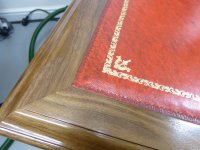I think that this is an interesting subject. We are machining wood, not metal, and wood not only changes shape and size (mostly when not wanted or expected) but it is very forgiving and allows a lot of adjustment during final assembly.
I try and work to 0.1 mm most of the time. Not because I expect everything to end up that close but because I want to avoid compound errors. In reality that means that at best I am within 0.4 mm on average and a bit of framing (or whatever) then ends up less than 0.5 - 0.6 mm out.
Now let me put those figures into perspective...
Router depth is measured to 0.1 mm but operator error and other factors will make this at best 0.2 mm.
Router positional accuracy (measured from an edge) is probably no better than 0.25 mm most of the time.
Kapex cut-off (I use an Incra Flip fence setup) is within 0.2 mm but again, rushing/operator error can make this 0.3 mm.
Domino accuracy (I use a pencil line most of the time) is at best 0.4 mm.
Planer (thicknesser) is calibrated to 0.1 mm and accurate to just under 0.15 mm but often better.
The key is to try to get as accurate as you can to reduce the overall error. Measuring diagonals is a good thing to do to check for square. Using an engineer's square is also good. Apart from the super Incra and Woodpeckers squares there are few run of the mill woodworker's squares that are worth the money.
At glue-up Domino joints are very forgiving (or rather the wood is forgiving) and a good knock in the right place can work wonders to achieve square.
Since I moved to Festool, started to use the Incra Precision rule and Flip Fence and stopped using normal woodworking squares (using the engineer's squares instead) I rarely have any issues at glue-up.
The other really useful thing to do is to use a drawing program to ensure that the designs are spot on and the dimensions are correctly calculated.
But the bottom line is the wood itself. It is a wonderful material, just like dear old Dad, it is very forgiving but you have to treat it with the utmost respect. Buy your wood sawn and in as close a thickness to what you want. When you rip it look out for movement and if it is important leave the wood for a week after ripping before planning and final thicknessing.
I hope this helps.
Peter
(corrected a spelling mistake - there may still be others)
I try and work to 0.1 mm most of the time. Not because I expect everything to end up that close but because I want to avoid compound errors. In reality that means that at best I am within 0.4 mm on average and a bit of framing (or whatever) then ends up less than 0.5 - 0.6 mm out.
Now let me put those figures into perspective...
Router depth is measured to 0.1 mm but operator error and other factors will make this at best 0.2 mm.
Router positional accuracy (measured from an edge) is probably no better than 0.25 mm most of the time.
Kapex cut-off (I use an Incra Flip fence setup) is within 0.2 mm but again, rushing/operator error can make this 0.3 mm.
Domino accuracy (I use a pencil line most of the time) is at best 0.4 mm.
Planer (thicknesser) is calibrated to 0.1 mm and accurate to just under 0.15 mm but often better.
The key is to try to get as accurate as you can to reduce the overall error. Measuring diagonals is a good thing to do to check for square. Using an engineer's square is also good. Apart from the super Incra and Woodpeckers squares there are few run of the mill woodworker's squares that are worth the money.
At glue-up Domino joints are very forgiving (or rather the wood is forgiving) and a good knock in the right place can work wonders to achieve square.
Since I moved to Festool, started to use the Incra Precision rule and Flip Fence and stopped using normal woodworking squares (using the engineer's squares instead) I rarely have any issues at glue-up.
The other really useful thing to do is to use a drawing program to ensure that the designs are spot on and the dimensions are correctly calculated.
But the bottom line is the wood itself. It is a wonderful material, just like dear old Dad, it is very forgiving but you have to treat it with the utmost respect. Buy your wood sawn and in as close a thickness to what you want. When you rip it look out for movement and if it is important leave the wood for a week after ripping before planning and final thicknessing.
I hope this helps.
Peter
(corrected a spelling mistake - there may still be others)

